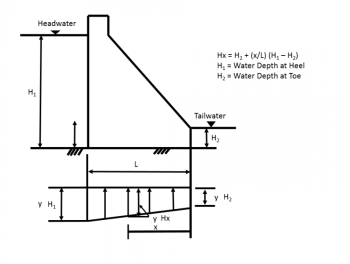Design and Construction of Gravity Dams: Difference between revisions
No edit summary |
No edit summary |
||
| Line 3: | Line 3: | ||
{| align="right" style="width:10%;" cellpadding="7" | {| align="right" style="width:10%;" cellpadding="7" | ||
| [[Image: | | [[Image:GravityDamUplift1.png|350px|x350px|link=https://damfailures.org/lessons-learned/concrete-gravity-dams-should-be-evaluated-to-accommodate-full-uplift/]] | ||
|- | |- | ||
|style="text-align:center; font-size:90%;"| Learn more about the need to consider uplift pressure when designing a gravity structure at [https://damfailures.org/lessons-learned/concrete-gravity-dams-should-be-evaluated-to-accommodate-full-uplift/ DamFailures.org] | |style="text-align:center; font-size:90%;"| Learn more about the need to consider uplift pressure when designing a gravity structure at [https://damfailures.org/lessons-learned/concrete-gravity-dams-should-be-evaluated-to-accommodate-full-uplift/ DamFailures.org] | ||
Revision as of 02:50, 16 September 2022

|
| Learn more about the need to consider uplift pressure when designing a gravity structure at DamFailures.org |
“Basically, gravity dams are solid concrete structures that maintain their stability against design loads from the geometric shape and the mass and strength of the concrete. Generally, they are constructed on a straight axis, but may be slightly curved or angled to accommodate the specific site conditions. Gravity dams typically consist of a nonoverflow section(s) and an overflow section or spillway. The two general concrete construction methods for concrete gravity dams are conventional placed mass concrete and roller-compacted concrete (RCC)”.[1]
Conventional Concrete Dams
“Construction procedures include batching and mixing, and transportation, placement, vibration, cooling, curing, and preparation of horizontal construction joints between lifts. The large volume of concrete in a gravity dam normally justifies an onsite batch plant, and requires an aggregate source of adequate quality and quantity, located at or within an economical distance of the project… The concrete is placed in lifts of 5- to 10-foot depths. Each lift consists of successive layers not exceeding 18 to 20 inches. Vibration is generally performed by large one-man, air-driven, spud-type vibrators”.[1]
Roller-Compacted Concrete (RCC) Gravity Dams
“The design of RCC gravity dams is similar to conventional concrete structures. The differences lie in the construction methods, concrete mix design, and details of appurtenant structures. Construction of an RCC dam is a relatively new and economical concept. Economic advantages are achieved with rapid placement using construction techniques that are similar to those employed for embankment dams. RCC is a relatively dry, lean zero slump concrete material containing coarse and fine aggregate that is consolidated by external vibration using vibratory rollers, dozer, and other heavy equipment. In the hardened condition, RCC has similar properties to conventional concrete. For effective consolidation, RCC must be dry enough to support the weight of the construction equipment, but have a consistency wet enough to permit adequate distribution of the past binder throughout the mass during the mixing and vibration process and, thus, achieve the necessary compaction of the RCC and prevention of undesirable segregation and voids".[1]
Examples
![]() Learn more about the need to consider uplift pressure (DamFailures.org)
Learn more about the need to consider uplift pressure (DamFailures.org)
![]() Learn from the critical oversights that led to the failure of St. Francis Dam (DamFailures.org)
Learn from the critical oversights that led to the failure of St. Francis Dam (DamFailures.org)
Best Practices Resources
![]() Gravity Dam Design (EM 1110-2-2200) (U.S. Army Corps of Engineers)
Gravity Dam Design (EM 1110-2-2200) (U.S. Army Corps of Engineers)
![]() Design Criteria for Concrete Arch and Gravity Dams (EM 19) (Bureau of Reclamation)
Design Criteria for Concrete Arch and Gravity Dams (EM 19) (Bureau of Reclamation)
![]() Design of Small Dams (Bureau of Reclamation)
Design of Small Dams (Bureau of Reclamation)
Trainings
![]() On-Demand Webinar: Introduction to Concrete Gravity Dams
On-Demand Webinar: Introduction to Concrete Gravity Dams
![]() On-Demand Webinar: Rehabilitation of Concrete Dams
On-Demand Webinar: Rehabilitation of Concrete Dams
Citations:
Revision ID: 3322
Revision Date: 09/16/2022
